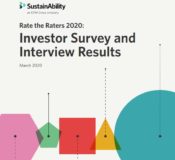
Bron
Sustainability
SustainAbility published the ‘Rate the Raters 2020 Report’. This research, the second installment of the 2019-2020 Rate the Raters project, explores how and why investors choose and use ESG ratings.
The report highlights investor views on current ESG ratings and how they use these ratings to evaluate ESG topics. It includes findings on where investors get ESG information, how often they use ESG ratings, investor critiques of ESG ratings and perceptions of specific ratings. The report also includes specific recommendations for companies on how to approach the ESG ratings landscape, get the most out of ESG ratings and improve ESG data disclosure.
Since the original Rate the Raters research series launched in 2010 and concluded in 2013, the size, influence and complexity of the ESG ecosystem have all increased significantly.

The number of ESG standards and frameworks, data providers, ratings and rankings has expanded, with 600+ ESG ratings and rankings existing globally as of 2018 and continuing to grow since. As this system has developed, it has influenced how companies report on and disclose ESG data and performance, shaped the creation of ESG-related investment products and framed the public perception of companies.
In this shifting environment, we consistently hear from corporate practitioners and colleagues that they are encouraged by increased investor interest in ESG performance, but struggle with how to best allocate limited resources to ESG ratings data collection and reporting. While keen to provide clear and useful ESG data and disclosure to investors, we find companies asking: How exactly are investors using our ESG data? Which ratings do investors use most, and how can that knowledge inform where companies focus? These core questions formed the foundation for this most recent Rate the Raters report.
This report shares insights from 17 in-depth interviews with investors, supplemented by a survey of 25 investors, highlighting their views on current ESG ratings and how they use these ratings to evaluate ESG topics. It includes findings on where investors get ESG information, how often they use ESG ratings, investor critiques of ESG ratings and perceptions of specific ratings. The report also includes specific recommendations for companies on how to approach the ESG ratings landscape, get the most out of ESG ratings and improve ESG data disclosure.



